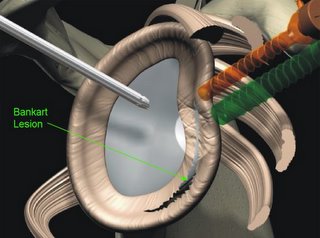
www.shoulderindia.com
Imagine a one day cricket match. The fielder at cover dives to catch the uppish shot. He misses and falls on his outstretched right hand. He experiences a sudden excruciating pain and is unable to move his arm. He is taken to the casualty of the nearest hospital where x rays reveal a dislocation of his right shoulder. It is put back into joint. Unfortunately he gets recurrent episodes of dislocation when taking his arm backwards at shoulder height.
SC, a scooterist applies brakes to avoid hitting a bull which suddenly decides to go for the garbage can on the other side of the road. He falls on his outstretched hand. Although he experiences a sudden momentary pain in his shoulder, he is able to move the arm. He brushes the dirt and drives off only to feel later episodes of pain when combing.
PV, an electrician gets a shock from a high voltage cable. He experiences sudden pain in the right shoulder and is unable to move the arm.
All these young men have some form of shoulder instability. The first is a frank case of recurrent dislocation, the second, a case of subtle instability, and the third a case of posterior dislocation which occurs after electrocution and in epileptics.
Anatomy
The Shoulder joint enjoys a very good range of movement at the price of stability. The shallow socket at the outer end of the shoulder blade receives the upper end of the arm bone. It is deepened by the attachment to its rim of the labrum, a band of connective tissue. After an injury, this labrum may be detached, thus leading to instability as it does not heal back in place.
Standard treatment
After confirmation of the direction of instability, the orthopedic surgeon may decide to stabilize the shoulder. More than one type of operation is available to treat this condition. However most of them do not address the anatomical abnormality. The golden standard of surgical treatment for anterior instability is a “Bankart repair”. This can be done by open methods or arthroscopically. The detached labrum is reattached back to its position.
The arthroscopic procedure is as effective as the open and has the advantage of being accomplished through minimally invasive key hole incisions.
The more subtle forms of instability as in the second case have to be differentiated from other causes of shoulder pain like impingement, rotator cuff tear, and calcium deposits and again be treated along the same line as a frank dislocation. After a very short period rehabilitation is commenced to regain the full range of movement. In anatomic repairs as above, full range of movement can be regained. However outdated and non anatomic repairs are used, some degree of movement is permanently lost.
No comments:
Post a Comment